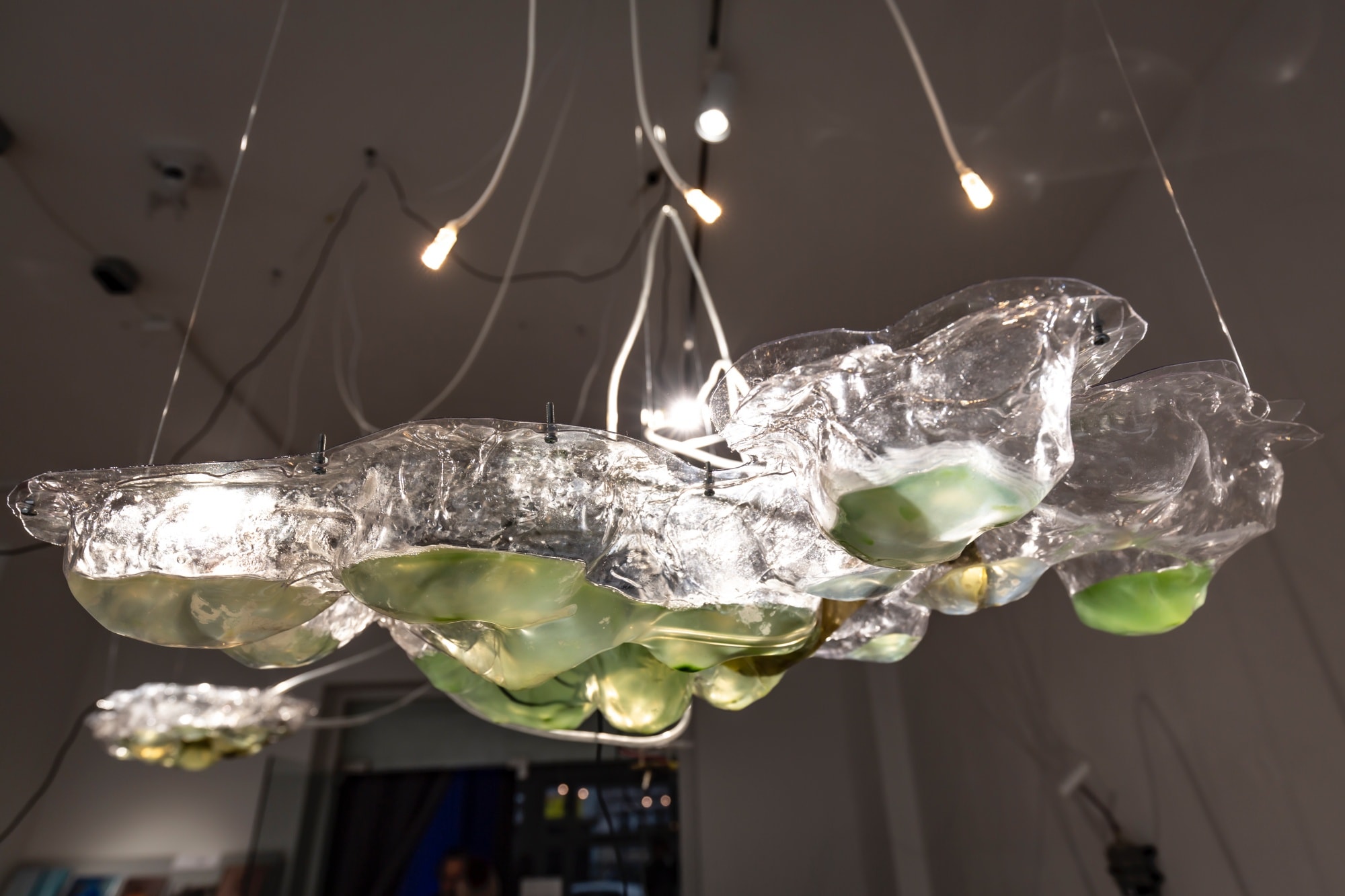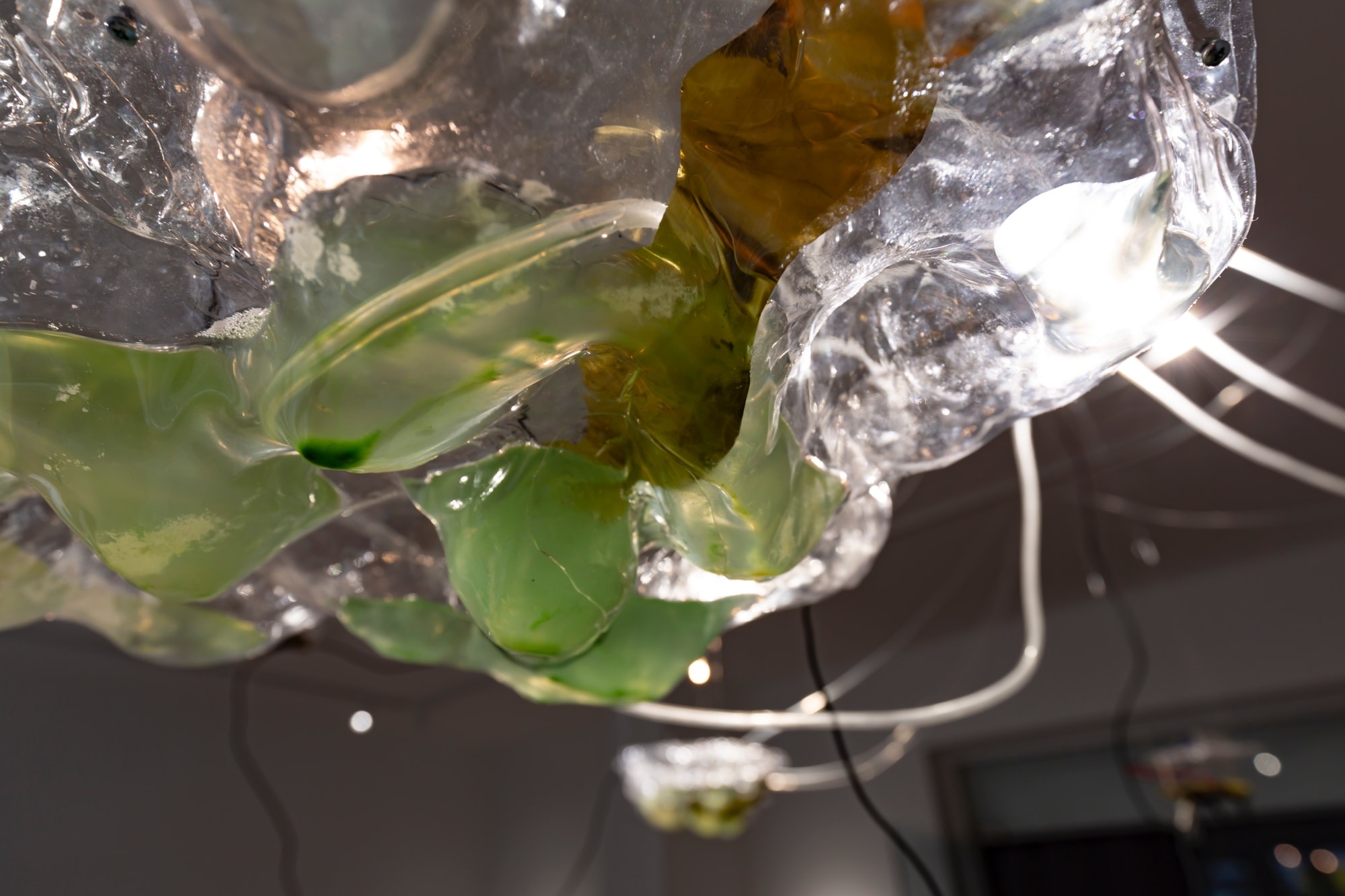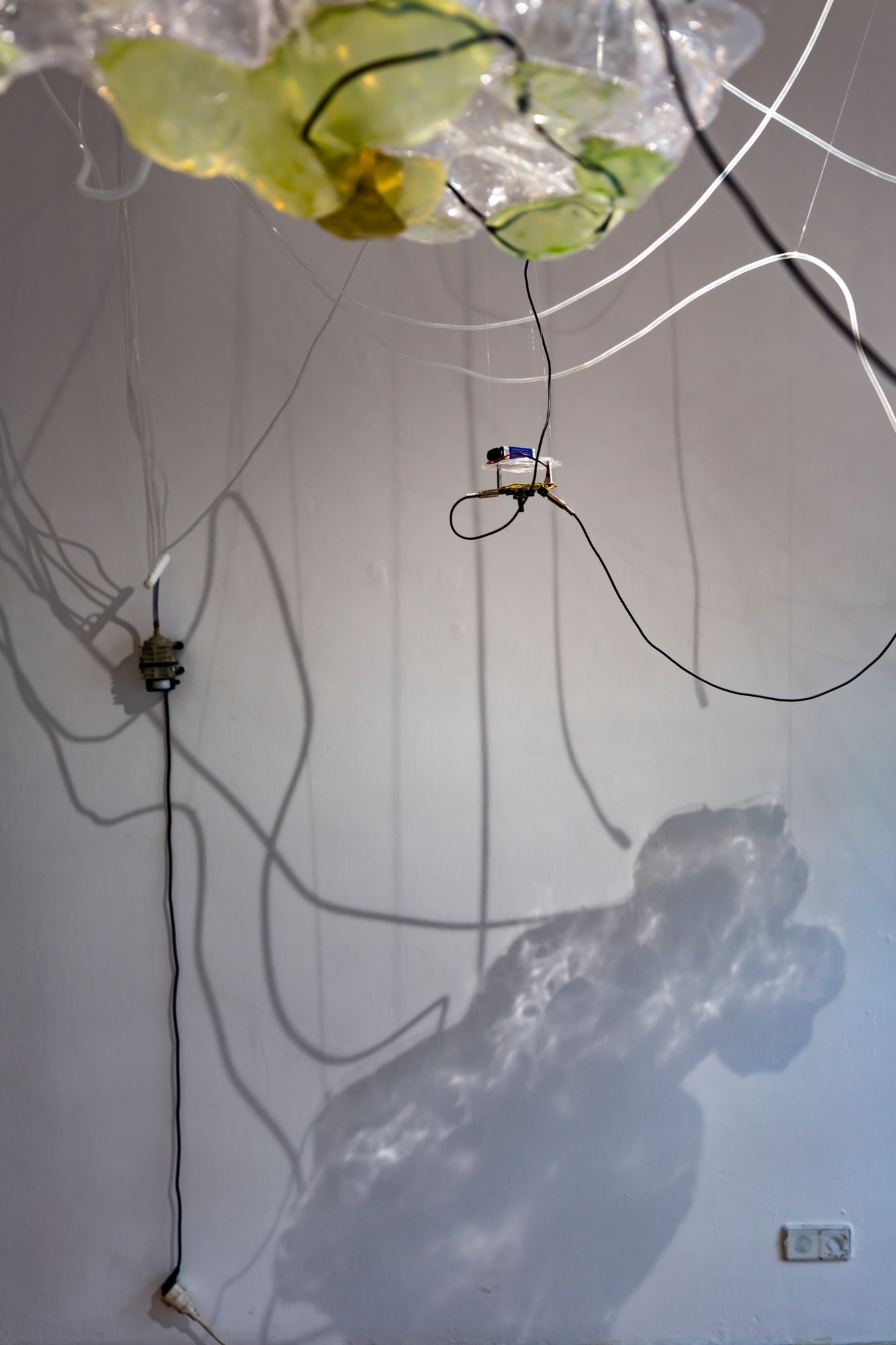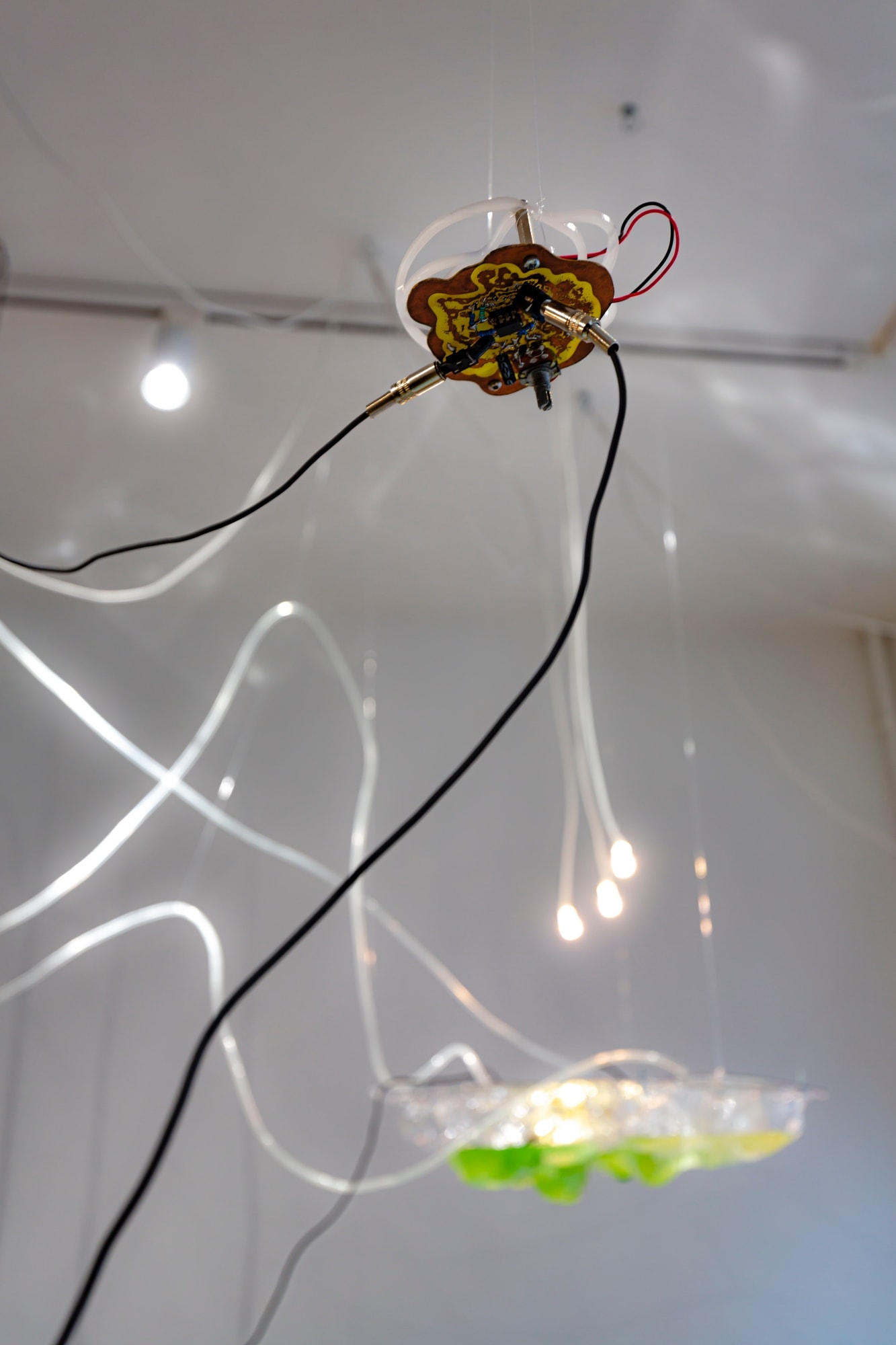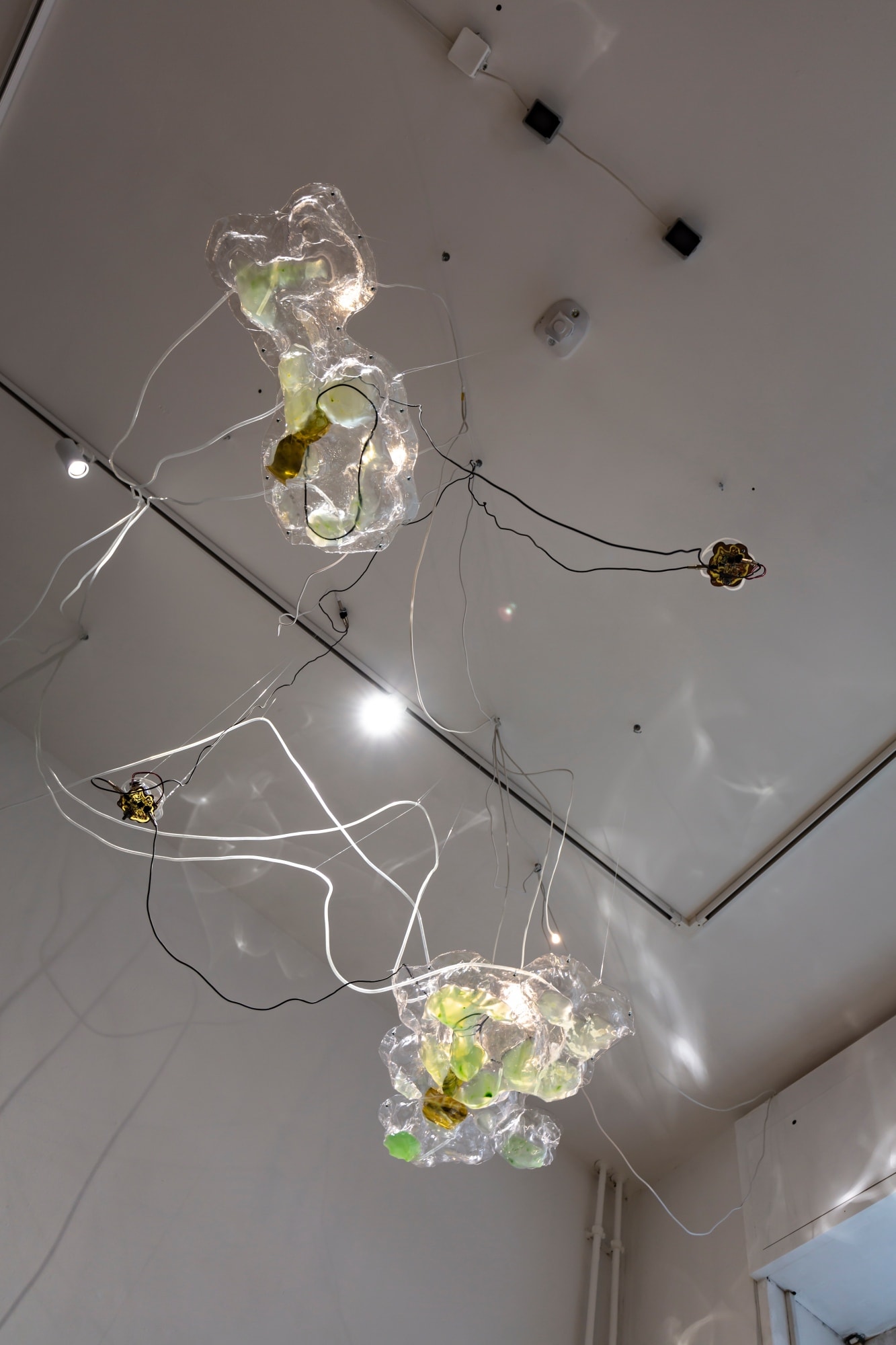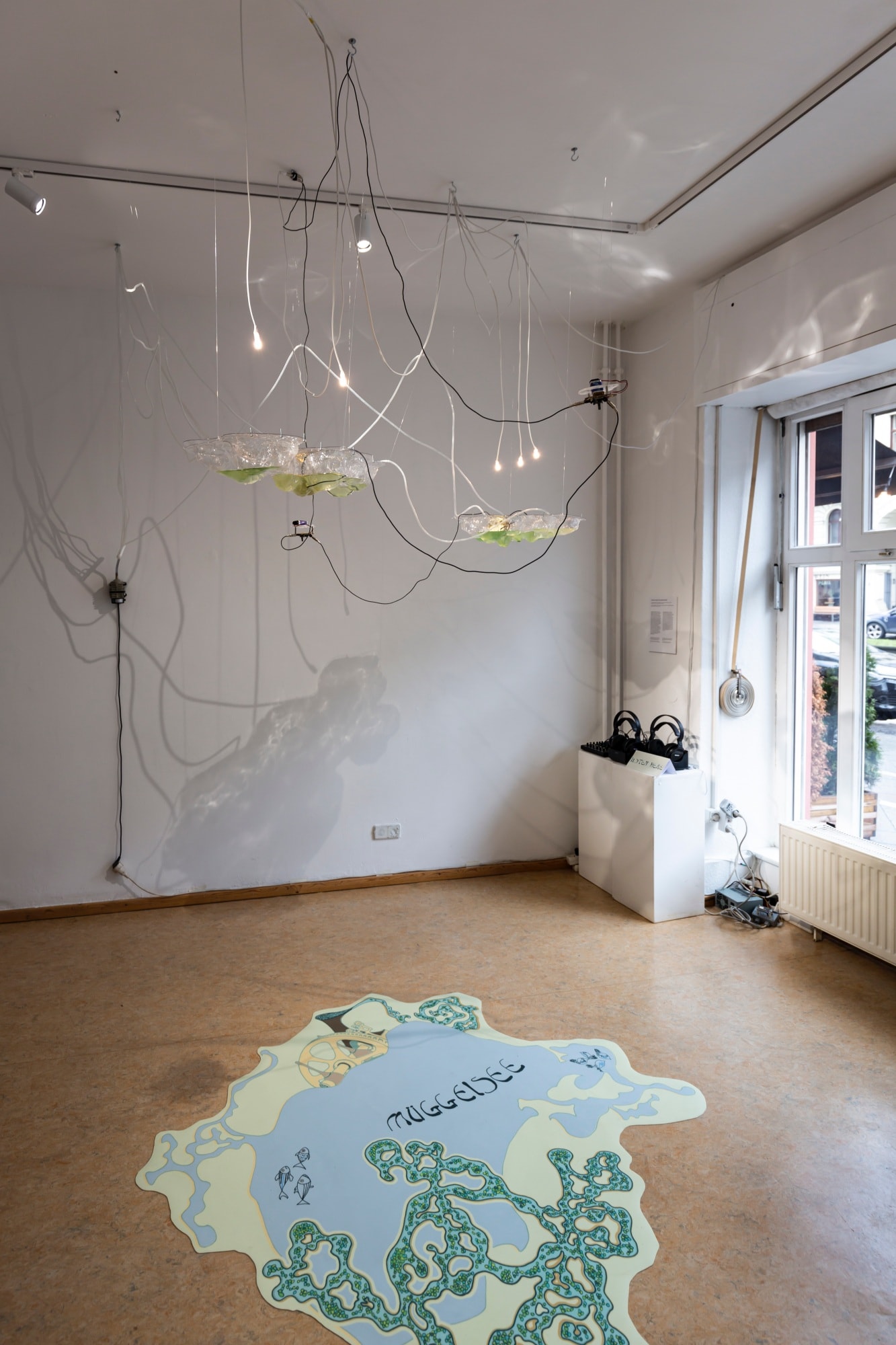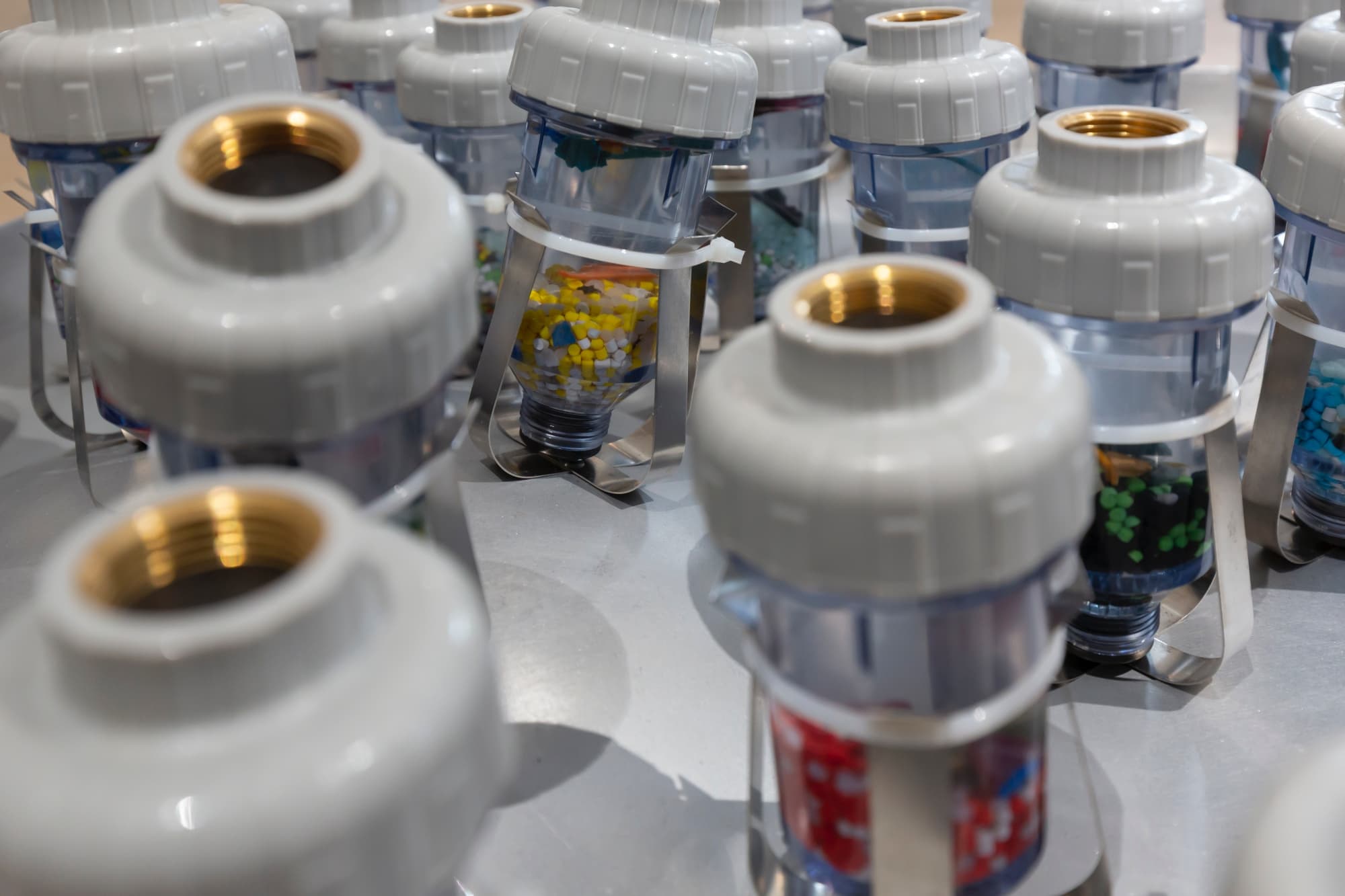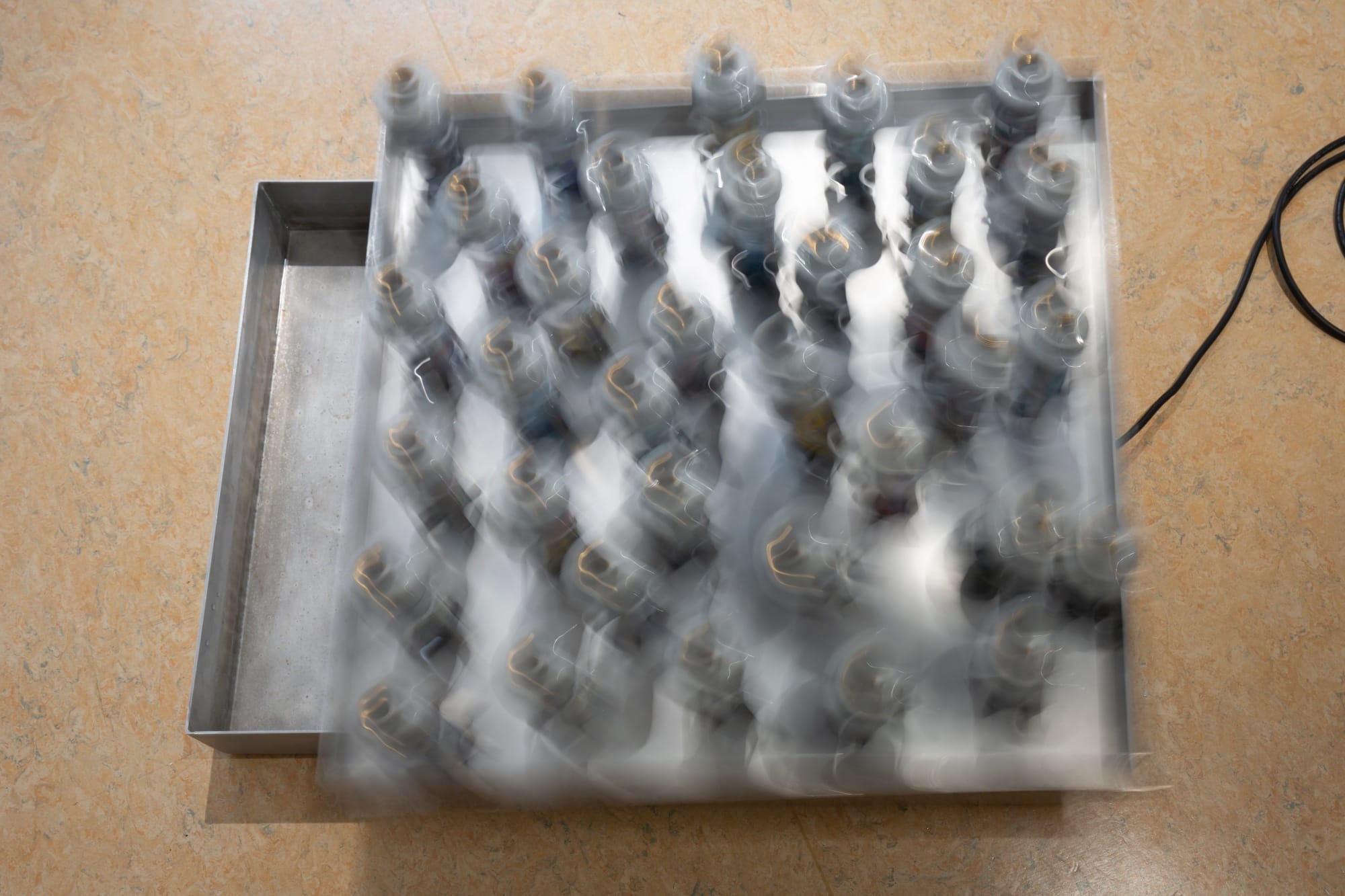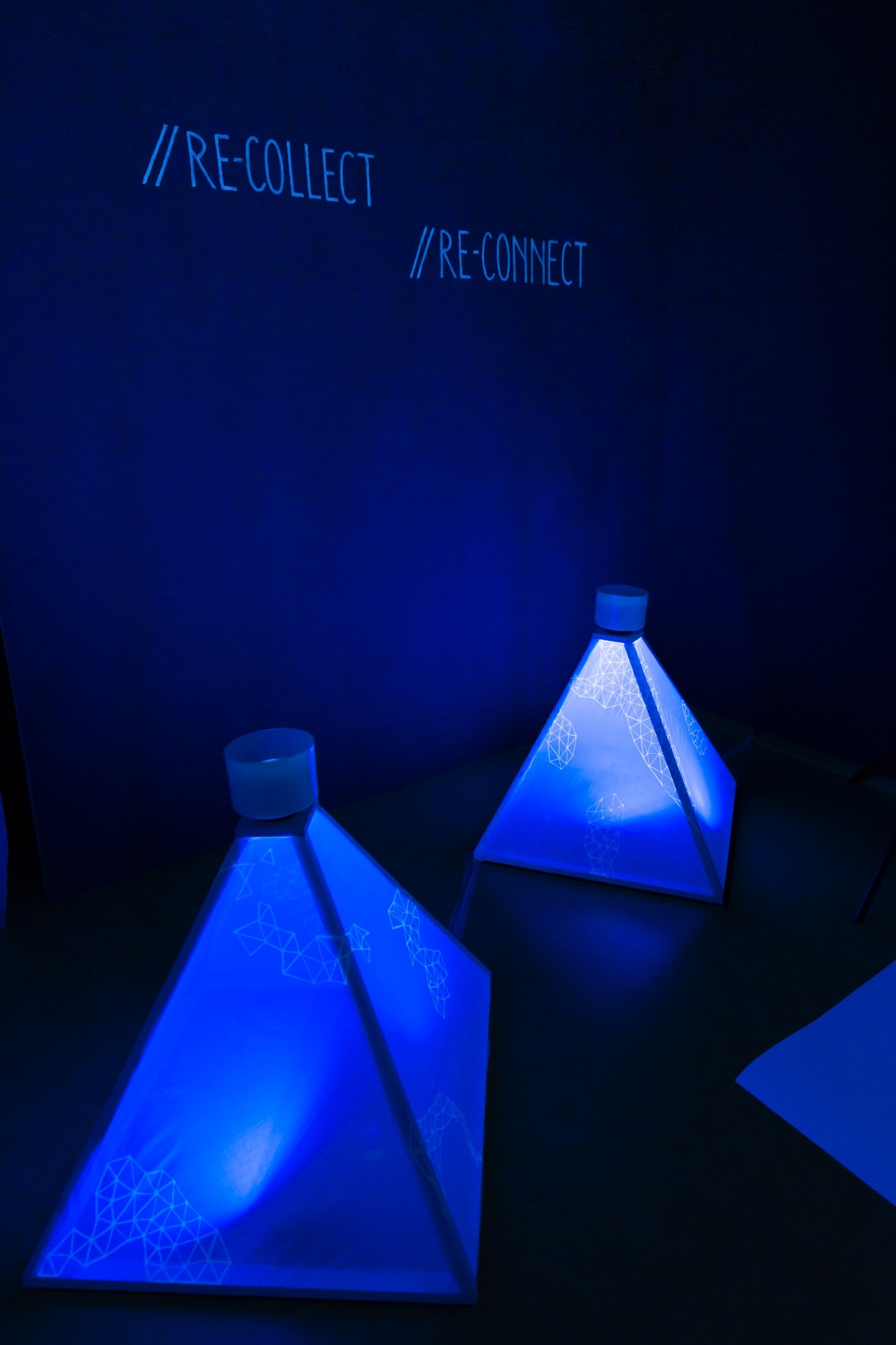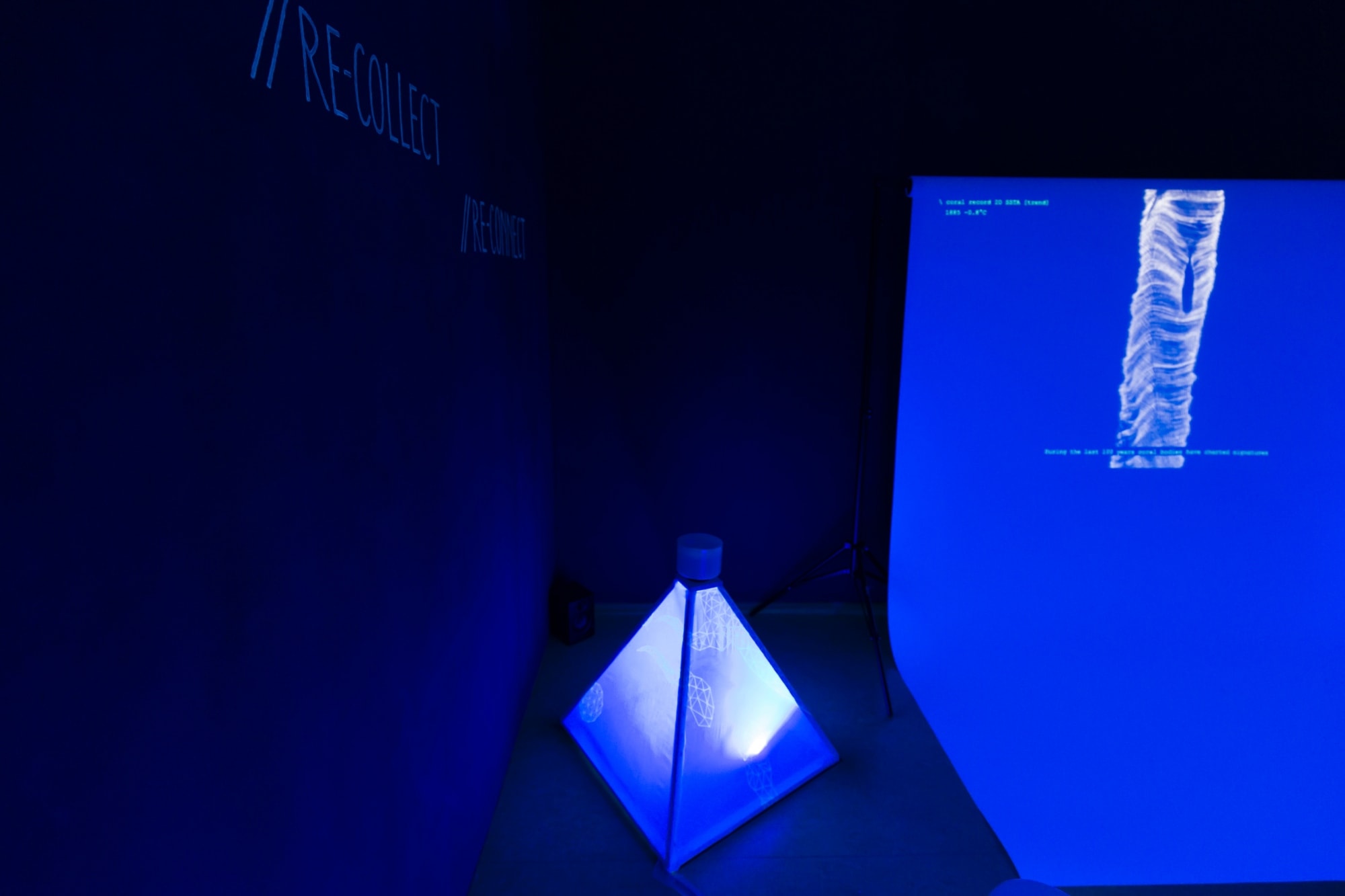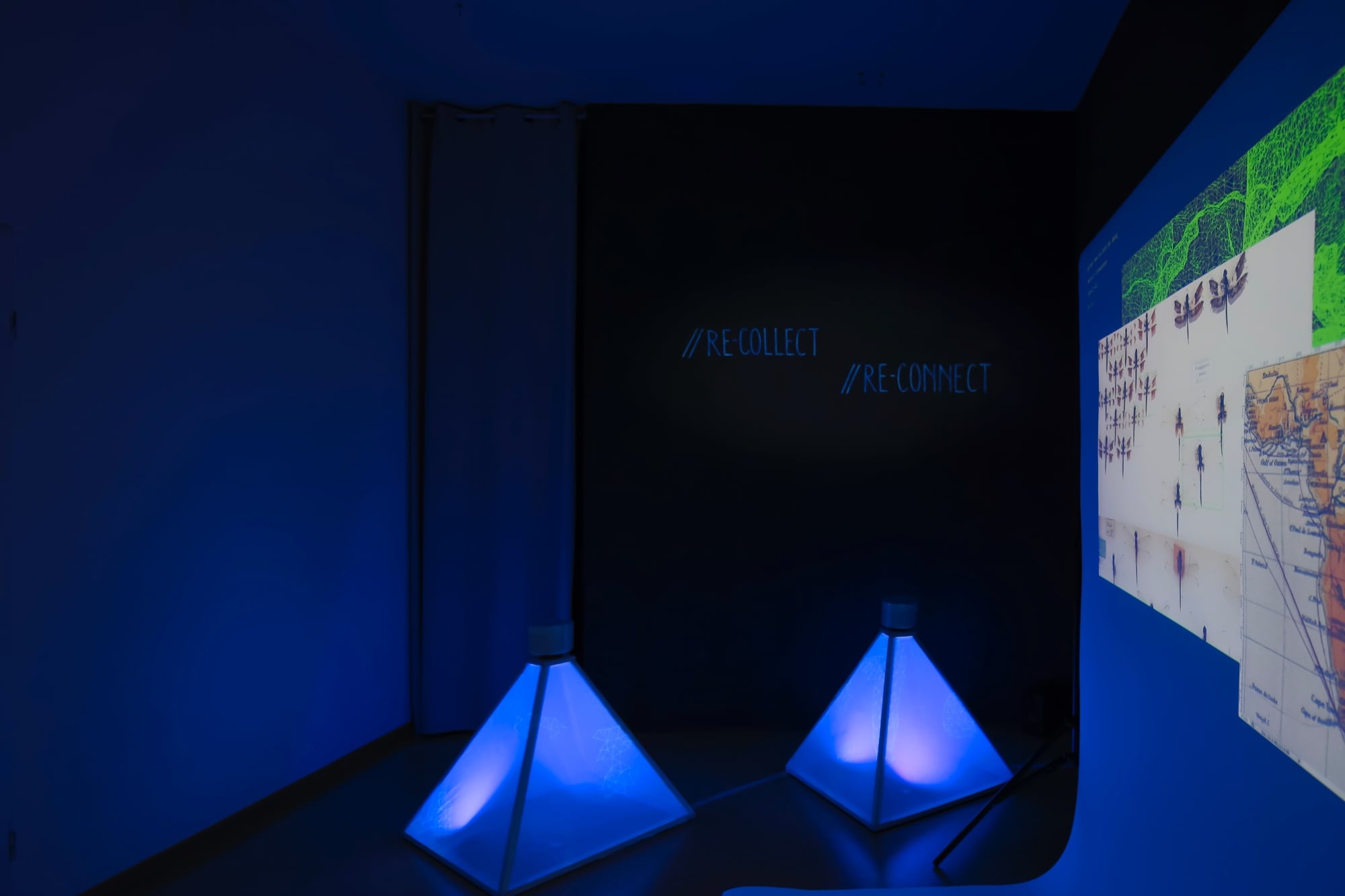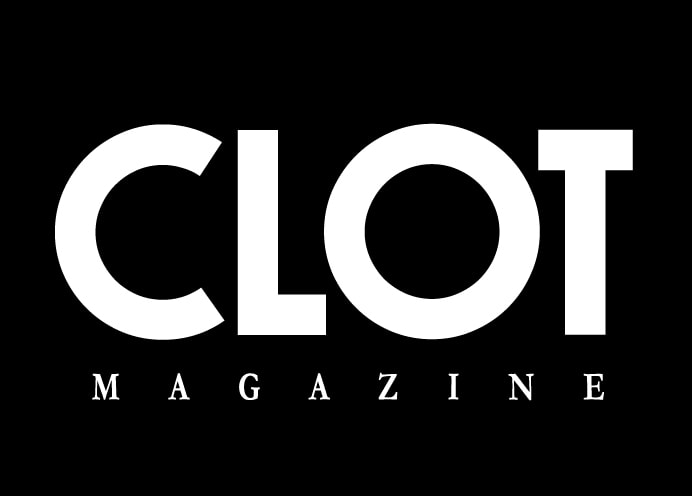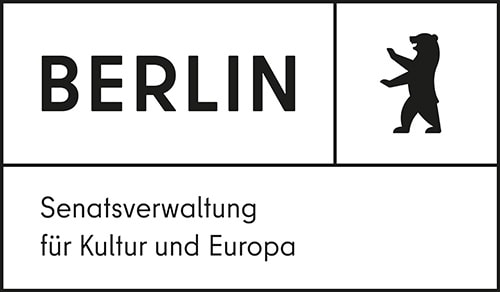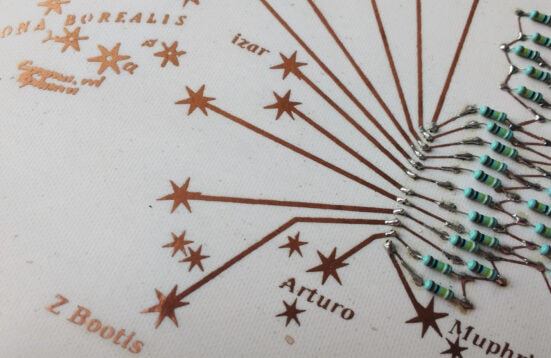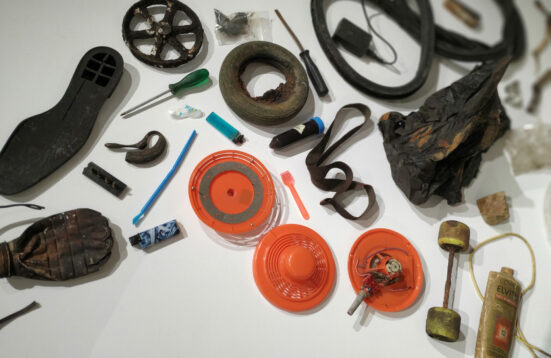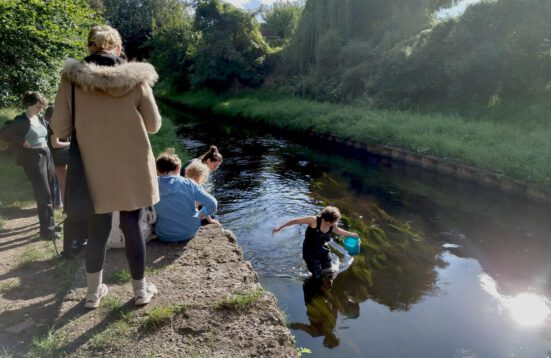In March 2022 scientific research revealed that microplastic pollution is now present in the human body. It moves around in the blood, lands in organs and passes to infants via breast milk. The exhibition title Vicious Cycle is based on this closed cycle of human disturbance of the environment and its return to the human and nonhuman body. In the exhibition the artists’ investigative and research-oriented works explore the problem of microplastics in soil, the impact of climate change and the effects of excessive agricultural activity on the water, soil, animals and wildlife.
Cammack Lindsey’s Wem gehört die Welt? is a site-specific sound installation based on the artist’s ongoing research on Müggelsee Berlin that features Microcystis aeruginosa and Müggelsee water samples in amorph containers in a network in-
spired by colony formations of most commonly toxin producing cyanobacterium Microcystis. As water pollution persists due to agricultural fertilisers and industrial disposals, the growth of toxic, along with non-toxic, cyanobacteria (also known as blue-green algae) blooms contaminate bodies of water. From historical and scientific analysis, what is the relationship of the occurrence of cyanobacteria blooms in Müggelsee to the economics of water: its price, consumption and treatment? Deriving its title from the 1932 film Kuhle Wampe oder Wem gehört die Welt?, written by Bertolt Brecht, this project pieces together stories within the setting of the Müggelsee lake from a proletarian lens.
Cammack Lindsey: Wem gehört die Welt?, 2023, sound installation, PCB, hydrophone, Microcystis aeruginosa, water samples from Müggelsee, epoxy/ thermoplastic containers, vinyl map, photo: Tim Deussen
Cammack Lindsey: Wem gehört die Welt?, 2023, sound installation, PCB, hydrophone, Microcystis aeruginosa, water samples from Müggelsee, epoxy/ thermoplastic containers, vinyl map, photo: Tim Deussen
Cammack Lindsey: Wem gehört die Welt?, 2023, sound installation, PCB, hydrophone, Microcystis aeruginosa, water samples from Müggelsee, epoxy/ thermoplastic containers, vinyl map, photo: Tim Deussen
Cammack Lindsey: Wem gehört die Welt?, 2023, sound installation, PCB, hydrophone, Microcystis aeruginosa, water samples from Müggelsee, epoxy/ thermoplastic containers, vinyl map, photo: Tim Deussen
Cammack Lindsey: Wem gehört die Welt?, 2023, sound installation, PCB, hydrophone, Microcystis aeruginosa, water samples from Müggelsee, epoxy/ thermoplastic containers, vinyl map, photo: Tim Deussen
Cammack Lindsey: Wem gehört die Welt?, 2023, sound installation, PCB, hydrophone, Microcystis aeruginosa, water samples from Müggelsee, epoxy/ thermoplastic containers, vinyl map, photo: Tim Deussen
Cammack Lindsey: Wem gehört die Welt?, 2023, sound installation, PCB, hydrophone, Microcystis aeruginosa, water samples from Müggelsee, epoxy/ thermoplastic containers, vinyl map, photo: Tim Deussen
Cammack Lindsey: Wem gehört die Welt?, 2023, sound installation, PCB, hydrophone, Microcystis aeruginosa, water samples from Müggelsee, epoxy/ thermoplastic containers, vinyl map, photo: Tim Deussen
Cammack Lindsey: Wem gehört die Welt?, 2023, sound installation, PCB, hydrophone, Microcystis aeruginosa, water samples from Müggelsee, epoxy/ thermoplastic containers, vinyl map, photo: Tim Deussen
Cammack Lindsey: Wem gehört die Welt?, 2023, sound installation, PCB, hydrophone, Microcystis aeruginosa, water samples from Müggelsee, epoxy/ thermoplastic containers, vinyl map, photo: Tim Deussen
Gülşah Mursaloğlu’s work Devouring the Earth, in Perishable Quantities contemplates the ways we devour the earth and the underground, both literally and metaphorically. Within the installation found and manufactured microplastics move around inside washing machine filters, creating an irregular yet continuous cycle of transformation. The work hosts various processes of leakage, amalgamation and digestion across different temporalities. It aims to underscore the entanglement within the acts of eating/ consuming/ devouring that is often promoted as choice-based as well as the points and practices of continuity between human and other agencies.
Gülşah Mursaloğlu: Devouring the Earth, in Perishable Quantities, 2020-ongoing, aluminium, washing machine filters, Arduino uno, motor, industrial and found microplastics, photo: Tim Deussen
Gülşah Mursaloğlu: Devouring the Earth, in Perishable Quantities, 2020-ongoing, aluminium, washing machine filters, Arduino uno, motor, industrial and found microplastics, photo: Tim Deussen
Gülşah Mursaloğlu: Devouring the Earth, in Perishable Quantities, 2020-ongoing, aluminium, washing machine filters, Arduino uno, motor, industrial and found microplastics, photo: Tim Deussen
Gülşah Mursaloğlu: Devouring the Earth, in Perishable Quantities, 2020-ongoing, aluminium, washing machine filters, Arduino uno, motor, industrial and found microplastics, photo: Tim Deussen
Gülşah Mursaloğlu: Devouring the Earth, in Perishable Quantities, 2020-ongoing, aluminium, washing machine filters, Arduino uno, motor, industrial and found microplastics, photo: Tim Deussen
Gülşah Mursaloğlu: Devouring the Earth, in Perishable Quantities, 2020-ongoing, aluminium, washing machine filters, Arduino uno, motor, industrial and found microplastics, photo: Tim Deussen
Gülşah Mursaloğlu: Devouring the Earth, in Perishable Quantities, 2020-ongoing, aluminium, washing machine filters, Arduino uno, motor, industrial and found microplastics, photo: Tim Deussen
Gülşah Mursaloğlu: Devouring the Earth, in Perishable Quantities, 2020-ongoing, aluminium, washing machine filters, Arduino uno, motor, industrial and found microplastics, photo: Tim Deussen
souvenirs entomologiques #1: odonata/ weathering data is a single-channel speculative video essay and installation by Sybille Neumeyer, that explores the entanglements of humans, weather and insects in a data-driven world in times of climate crisis. It follows dragonflies on multiple scales through time and space: from their geological past into uncertain futures, from ecosystems to museum collections, from embodied weather worlds into detached data clouds, while multiple insect identities are mediated, shaped and reshaped by co-evolving modes of mapping, monitoring and collecting. Although data-based ontologies promise measures of anticipating and controlling futures, the recollection of local eco–logical knowledge reframes observation as the practice of care.
Sybille Neumeyer: souvenirs entomologiques #1: odonata/ weathering data, 2020, installation, photo: Tim Deussen
Sybille Neumeyer: souvenirs entomologiques #1: odonata/ weathering data, 2020, installation, photo: Tim Deussen
Sybille Neumeyer: souvenirs entomologiques #1: odonata/ weathering data, 2020, installation, photo: Tim Deussen
Sybille Neumeyer: souvenirs entomologiques #1: odonata/ weathering data, 2020, installation, photo: Tim Deussen
Sybille Neumeyer: souvenirs entomologiques #1: odonata/ weathering data, 2020, installation, photo: Tim Deussen
Sybille Neumeyer: souvenirs entomologiques #1: odonata/ weathering data, 2020, installation, photo: Tim Deussen
Sybille Neumeyer: souvenirs entomologiques #1: odonata/ weathering data, 2020, installation, photo: Tim Deussen
Sybille Neumeyer: souvenirs entomologiques #1: odonata/ weathering data, 2020, installation, photo: Tim Deussen
Sybille Neumeyer: souvenirs entomologiques #1: odonata/ weathering data, 2020, installation, photo: Tim Deussen
Sybille Neumeyer: souvenirs entomologiques #1: odonata/ weathering data, 2020, installation, photo: Tim Deussen
Sybille Neumeyer: souvenirs entomologiques #1: odonata/ weathering data, 2020, installation, photo: Tim Deussen
Press Feedback
Insight: Vicious Cycle, raising awareness about the climate crisis & the effects of excessive agricultural activity, in CLOT by Lyndsey Walsh (16 March 2023)
Schön schmutzig. Im Teufelskreis von Mikroplastik und anderen Umweltsünden, in art-in-berlin by Katja Hock (21 March 2023)
Das Wasser als Objekt der Kunst, in taz by Tom Mustroph (16 March 2023)

